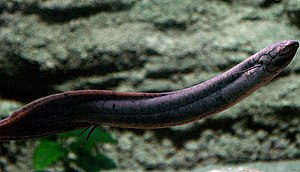South American lungfish
| South American lungfish | ||||||||||||
|---|---|---|---|---|---|---|---|---|---|---|---|---|

South American lungfish ( Lepidosiren paradoxa ) |
||||||||||||
| Systematics | ||||||||||||
|
||||||||||||
| Scientific name of the family | ||||||||||||
| Lepidosirenidae | ||||||||||||
| Bonaparte , 1841 | ||||||||||||
| Scientific name of the genus | ||||||||||||
| Lepidosis | ||||||||||||
| Fitzinger , 1837 | ||||||||||||
| Scientific name of the species | ||||||||||||
| Lepidosis paradoxa | ||||||||||||
| Fitzinger, 1837 |
The South American lungfish ( Lepidosiren paradoxa ) is the only species of lungfish in South America . He lives in Brazil , in the Amazon and in the Gran Chaco , in Paraguay and in the lower basin of the Río Paraná . The fish are particularly common in the northern Gran Chaco. He was described as the first recent sarcopterygian in 1837.
features
The South American lungfish has an elongated, eel-like body, the cross-section of which is round in front of the pelvic fins. The scales are very small, the thread-like pectoral and ventral fins shorter than those of the African lungfish . The dorsal , caudal and anal fins have grown together to form a continuous fin edge. South American lungfish have five gill arches and four gill slits. They are gray-brown, occasionally with black spots, the young are black-brown or completely black. Their maximum height is 1.25 meters, the maximum proven age eight years. Because of their amphibian-like appearance, they are also called scale newts in German .
Way of life
Like all lung fish, they are sluggish, slow moving fish. They prefer swamps and calm, at most slowly flowing, heavily weed bodies of water that can also be very low in oxygen. The fish are compulsory air breathers and will suffocate if prevented from rising to the surface of the water. They survive the dry season , buried 30 to 50 centimeters deep in the mud of the ground. Your metabolism is reduced during the dry season. In contrast to the African lungfish, however, they do not survive a complete drying out of their living waters.
Adult animals are omnivores and feed on smaller aquatic vertebrates, crustaceans, algae and especially apple snails (Ampullariidae). Young fish eat insects and snails.
Reproduction
South American lungfish spawn at the beginning of the rainy season in self-made tunnels up to 1.5 meters long. The spawn and larvae are guarded by the males. During the brood care, the males grow fringed, gill-like appendages on the pelvic fins. However, these work opposite to gills, they give off oxygen and take up carbon dioxide . This allows the males to improve the oxygen supply to the clutch. After the end of the breeding season, these attachments disappear again.
The eggs are rich in yolk and large. The larvae have four pairs of pinnate outer gills and an adhesive gland on the belly. They resemble the larvae of the tail amphibian. At first they only breathe with the gills , after six to eight weeks they can breathe air and the outer gills disappear.
literature
- Kurt Fiedler: Textbook of Special Zoology. Volume 2, Part 2: Fish. Gustav Fischer Verlag, Jena 1991, ISBN 3-334-00339-6 .
- Joseph S. Nelson: Fishes of the World. John Wiley & Sons, 2006, ISBN 0-471-25031-7 .
- Günther Sterba : The world's freshwater fish. 2nd Edition. Urania, Leipzig / Jena / Berlin 1990, ISBN 3-332-00109-4 .
Web links
- South American Lungfish on Fishbase.org (English)
